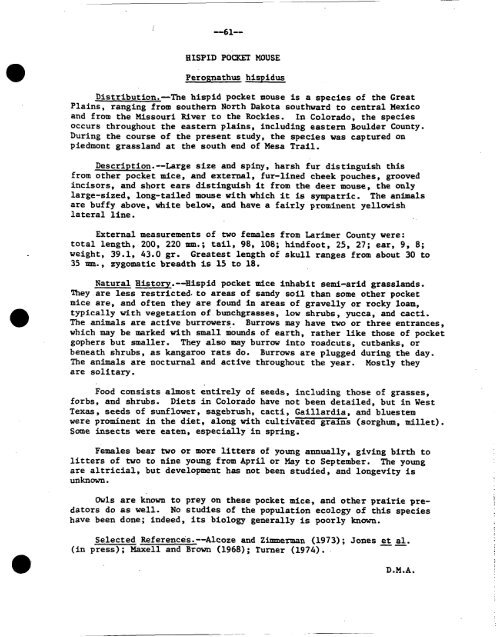Create successful ePaper yourself
Turn your PDF publications into a flip-book with our unique Google optimized e-Paper software.
HISPID POCKET MOUSE<br />
Perognathus hispidus<br />
Distribution.-The hispid pocket mouse is a species <strong>of</strong> the Great<br />
Plains, ranging from southern North Dakota southward to central Mexico<br />
and from the Missouri River to the Rockies. In Colorado, the species<br />
occurs throughout the eastern plains, including eastern <strong>Boulder</strong> County.<br />
During the course <strong>of</strong> the present study, the species was captured on<br />
piedmont grassland at the south end <strong>of</strong> Mesa Trail.<br />
Description.--Large size and spiny, harsh fur distinguish this<br />
from other pocket mice, and external, fur-lined cheek pouches, grooved<br />
incisors, and short ears distinguish it from the deer mouse, the only<br />
large-sized, long-tailed mouse with which it is sympatric, The animals<br />
are buffy above, white below, and have a fairly prominent yellowish<br />
lateral line.<br />
External measurements <strong>of</strong> two females from Larimer County were:<br />
total length, 200, 220 mm.; tail, 98, 108; hindfoot, 25, 27; ear, 9, 8;<br />
weight, 39.1, 43.0 gr. Greatest length <strong>of</strong> skull ranges from about 30 to<br />
35 mm., zygomatic breadth is 15 to 18.<br />
Natural History.--Hispid pocket mice inhabit semi-arid grasslands.<br />
They.are less restricted.to areas <strong>of</strong> sandy soil than some other pocket<br />
a<br />
mice are, and <strong>of</strong>ten they are found in areas <strong>of</strong> gravelly or rocky loam,<br />
typically with vegetation <strong>of</strong>.bunchgtasses, low shrubs, yucca, and cacti.<br />
The animals are active burrowers. Burrows may have two or three entrances,<br />
which may be marked with small mounds <strong>of</strong> earth, rather like those <strong>of</strong> pocket<br />
gophers but smaller. They also may burrow into roadcuts, cutbanks, or<br />
beneath shrubs, as kangaroo rats do. Burrows are plugged during the day.<br />
The animals are nocturnal and active throughout the year. Mostly they<br />
are solitary.<br />
Food consists almost entirely <strong>of</strong> seeds, including those <strong>of</strong> grasses,<br />
forbs, and shrubs. Diets in Colorado have not been detailed, but in West<br />
Texas, seeds <strong>of</strong> sunflower, sagebrush, cacti, Gaillardia, and bluestem<br />
were prominent in the diet, along with cultivated grains (sorghum, millet).<br />
Some insects were eaten, especially'in spring.<br />
Females bear two or more litters <strong>of</strong> young annually, giving birth to<br />
litters <strong>of</strong> two to nine young from April or May to September. The young<br />
are altricial, but development has not been studied, and longevity is<br />
unknown.<br />
Owls are known to prey on these pocket mice, and other prairie pre-<br />
dators do as well. No studies <strong>of</strong> the population ecology <strong>of</strong> this species<br />
have been done; indeed, its biology generally is poorly known.<br />
Selected References.--Alcoze and Zimmerman (1973); Jones et al.<br />
(in press); Maxell and Brown (1968); Turner (1974).<br />
D.M.A.















